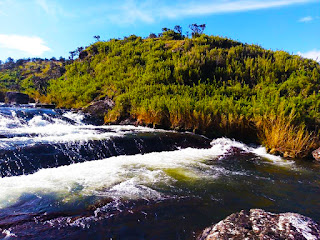Horton
Plains National Park
Horton plains have an interesting history behind it with
the discovery of early stone tools dating back to the Balangoda Culture (According to Archaeological sequences the earliest evidence of Balangoda Man
at caves and other site dates back to 38,000 BP).
Horton Plains National Park
is a popular tourist destination and is situated 32 kilometers (20 mi) from
Nuwaraeliya city. Horton Plains National Park In Sinhalese the plains are known
as “Maha Eliya Thenna” (මහ එළිය තැන්න). The original name of
the area was "Maha Eliya Thenna" (මහ එළිය තැන්න "great open
plain"). But during the British Ceylon period, the plains were renamed as
"Horton plains" after “Sir Robert Wilmot- Horton’s” (1831 -1837).
Horton Plains is located on the southern plateau of the central highlands of
Sri Lanka. Horton Plains National Park is a national park in the central
highlands of Sri Lanka (Ceylon) that was designated in 1988. It is located at
an elevation of 2,100M – 2,300M and encompasses Montane grassland & Cloud
forest. Horton Plains, its surroundings, forests, and the adjoining Peak
Wilderness constitute Sri Lanka’s most important catchment area of almost all
major rivers. It is rich in biodiversity and many species found here are
endemic to the region.
Horton Plains was designated
as a wildlife Sanctuary on 5 December 1969, and because of its biodiversity
value, it was elevated to a National park on 18 March 1988. The land area
covered by Horton Plains is 3,160 hectares & it contains the most extensive
area of cloud forest still existing in Sri Lanka. In July 2010, “The Central
Highlands of Sri Lanka” which incorporates Horton Plains National Park, Peak
Wilderness Sanctuary & Knuckles Mountain Range was inscribed on the World
Heritage List.
The sheer precipice of world’s
End, Baker’s Falls, Thotupola Mountain (2,357M) & Kirigalpoththa mountain
hike (2,389M) has been the main tourist attractions places of the park. The
peaks of Kirigalpoththa mountain and Thotupola Mountain, the second and the
third highest peaks of Sri Lanka. The mean annual rainfall is more than 2,000
millimeters. The mean annual temperature is 13°C ( 55°F ) but the temperature
varies considerably during the course of a day, reaching as high as 27°C (81°F) during the day time, and dipping as low as 5°C (41°F) at night.
The Horton plains plateau
comes to a sudden end at World’s End a stunning escarpment that plunges 1050m.
The walk begins at the entrance and it has 4 km to reach Word’s End, but the
trail then loops back to Baker’s Falls (2km) and continue back to the entrance
(another 3.5km). The 9.5km round trip takes a leisurely 3hrs & 30min.
Unless you get there early, the view from world’s end is often obscured by
mist, particularly during the rainy season from April to September. All you can
expect to see from World’s End after around 9 am is a swirling white wall. The
early morning (between 6 am and 10 am) is the best time to visit before the
clouds roll in. Try to avoid doing this walk on weekends and Sri Lankan public holidays,
when it can get crowded.
To Kirigalpoththa Mountain
hike, have 6km distance to trek & it's taken almost 3 hours to the summit
from the starting point. The Thotopola Mountain hike takes approximately 1 hour
to reach the peak and trail length is around 1.3km. If you plan to do those
hikes you should wear thick clothes that will protect your skin from brambles
and such and tall skidproof boots to avoid slipping in the mud.
Close to 750 species of
plants have been observed here; this includes dwarf bamboo species (some
endemic to Sri Lanka), Myrtaceae and Lauraceae species, and many varieties of
ferns, lichens, and orchids amongst others. The fauna of the region includes 24
species of mammals, 87 species of birds, 09 species of reptiles, 15 species of
amphibians, and 02 species of fish. Of the mammals, the most commonly seen are
the Sambar deer with a population close to 2000. Others include Toque macaques,
Purple-faced langur, Kelaart’s long-clawed shrews, Sri Lankan Leopard, Wild
boa; Strip necked mongoose, Spotted chevrotain, Giant squirrels, Fishing cat
and one of the world’s most endangered primates, the Red slender loris.
The Thotupola Mountain has Ravana
Related stories also. Some people believe Thotupola mountain is used as an Aerodrome (airport) for Ravana’s Flying Machine (Dandu Monara).













����❤️
ReplyDelete